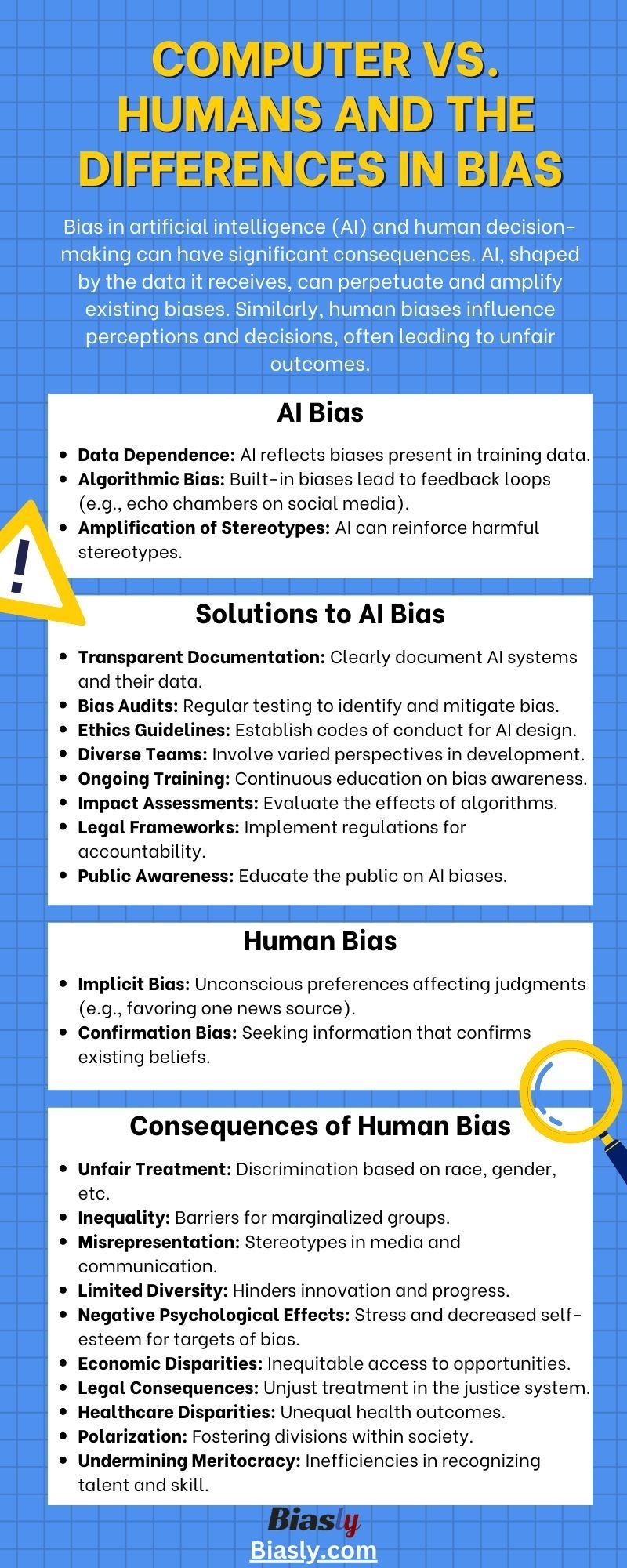
There are several ways artificial intelligence (AI) can commit bias. AI is a human construct and therefore acts on the information data scientists feed it. This means that if the data humans supply AI with is biased, so will the output.
Additionally, algorithmic bias occurs when AI is built with a particular bias. If AI repeatedly makes subjective assessments based on old biases, it generates a feedback loop bias. An example of this occurred on social media platforms when algorithm’s reinforce an environment based on past actions and an echo chamber effect occurs.
So when you only see opinions that mirror your own on a platform, it is likely that you are experiencing the platform’s AI feedback loop bias. Complex tasks that we often expect AI to solve or do better than humans do not miraculously get solved when prejudice is present.
In fact, AI can amplify the biases of its creator, such as stereotypes. AI has many merits, but eliminating discrimination remains an essential feature of its design. AI designers should be accountable for their AI’s bias and its unintended negative consequences. How can all of this be accomplished? Here are a few ways to eliminate AI bias:
- Transparent Documentation and Reporting
- Bias Audits and Testing
- Ethics Guidelines and Codes of Conduct
- Diverse and Interdisciplinary Teams
- Ongoing Education and Training
- Algorithmic Impact Assessments
- Legal and Regulatory Frameworks
- Liability and Accountability Frameworks
- Redress Mechanisms
- Public Awareness and Education
- Incentives for Fairness
Human Bias
Human biases in politics are often misleading and show up in news reporting and even media rating agencies that have inherent biases and leanings within their organizations. Both human bias and AI bias can misrepresent the truth, but not the same, and humans are far more susceptible to bias than well-balanced A.I. algorithms.
Humans can exhibit several forms of bias, including:
| TYPE | DEFINITION | EXAMPLE |
| Implicit Bias | When one’s judgment is affected by their negative or positive unconscious views. | If someone presumes that one news source is better without confirmation, implicit bias is present. |
| Confirmation Bias | When one seeks out and gives more weight to information congruent to one’s beliefs. | A news report that relies too heavily on one side of the story because of its slant is an example of confirmation bias. |
| Stereotyping | When one makes assumptions about individuals based on their group characteristics. | If one avoids smaller outlets because they lack glamor, stereotyping is taking place. |
| Availability Bias | When one does not thoroughly research before deciding and instead use what is readily available. | If you read articles from only one newspaper, you are likely not exposed to varying viewpoints and thus your research suffers from availability bias. |
| Halo Effect | When one’s superficial impression dominates one’s judgment. | If you are superficially attracted to a news source and subsequently favor it, your research will suffer from the halo effect. |
| Anchoring Bias | When one relies too heavily on one’s first source. | If you do not research with multiple sources, but rely on the first source you read, your research suffers from anchoring bias. |
| Availability Heuristic | When one’s overestimation of importance or likelihood of events is based on how easily examples come to mind. | If one overly commits to a new source’s theory because it is easily accessible, one’s research suffers from availability heuristic. |
| In-Group Bias | When one favors individuals or groups perceived to be similar to oneself, often leading to preferential treatment and exclusion of those outside the group. | If one rejects to acknowledge a news source because of its cultural origins, one’s research suffers from in-group bias. |
Bias in politics can have real consequences. Consequences of human bias include:
- Unfair Treatment: Bias can lead to unfair treatment of individuals or groups based on their characteristics such as race, gender, religion, or age.
- Inequality and Social Injustice: Marginalized groups may face barriers to opportunities and resources due to biased attitudes and practices, leading to a cycle of disadvantage.
- Misrepresentation: Bias can result in the misrepresentation of certain groups in media, education, and other forms of communication. Stereotypes and inaccurate portrayals can reinforce biased beliefs and limit understanding between different groups.
- Limited Diversity: Bias can discourage diversity in various fields, including the workplace and academia. When certain groups are systematically excluded or discouraged, it can limit the potential for innovation and progress.
- Stifled Creativity and Innovation: Biases can stifle the free exchange of ideas by favoring familiar or mainstream perspectives. This can hinder creative thinking and prevent the exploration of alternative solutions to problems.
- Negative Psychological Effects: Individuals who are targets of bias can experience psychological distress, anxiety, and decreased self-esteem due to the stress of navigating biased environments. This can impact their overall well-being.
- Economic Disparities: Bias can contribute to economic disparities, as individuals facing bias may have limited access to quality education, employment opportunities, and financial resources.
- Legal and Criminal Justice Consequences: Unfair treatment within the legal and criminal justice systems, such as racial profiling, can lead to unjust arrests and sentencing disparities.
- Healthcare Disparities: Bias in healthcare settings can lead to differential treatment and misdiagnoses, resulting in unequal health outcomes for different groups.
- Polarization and Division: Bias can contribute to societal polarization by fostering “us vs. them” mentalities. This can lead to tensions and conflicts between different groups.
- Undermining Meritocracy: Bias can undermine the principle of meritocracy, where individuals are rewarded based on their skills and abilities rather than their characteristics. This can lead to inefficiencies and suboptimal outcomes.
- Missing Opportunities: Bias can cause individuals and organizations to overlook valuable contributions, talents, and opportunities that are not aligned with their biased perspectives.























